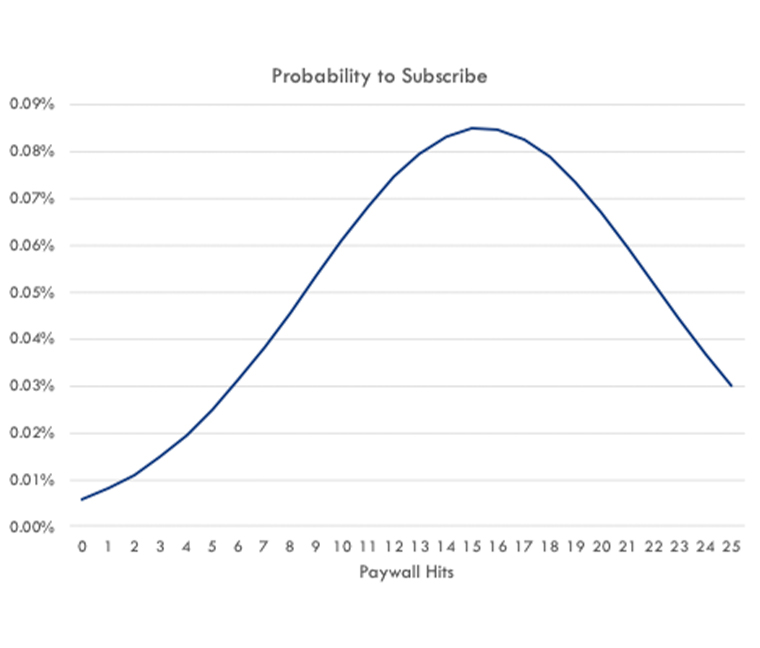Matt Lindsay, President
Arvid Tchivzhel, Senior Director Product Development
25 November 2019
Using propensity modeling to identify readers on a Web site that are likely to subscribe is a growing trend in the industry. Pioneers such as The Wall Street Journal have demonstrated the effectiveness of changing the user journey and the acquisition tactics based on an individual’s likelihood of subscribing to maximise subscription sales while minimising lost advertising revenue.

Understanding the change in subscription propensity helps publishers identify the best strategies for improving conversions.
Mather Economics has developed models of subscription propensity for many publishers, and we are helping them deploy those models within their existing paywalls and tech stacks. While working with publishers on these models, we have observed the marginal effects on subscription propensity from several factors common to propensity models: modal hits, days on site, article pageviews, time per visit, scroll depth, content breadth, and many other variables.
Marginal effects refer to the change in subscription propensity from a change in each of these metrics. For instance, if reading another article substantially increases a reader’s propensity to subscribe, tactics can be developed to encourage additional article consumption. Understanding these marginal effects help publishers identify the best strategies to improve conversions and grow digital subscription sales.
There are four primary inputs that explain propensity to subscribe:
- User engagement (pageviews, visits, time on site, etc.).
- Environment (device, location, day of the week, time of day, etc.).
- Product (content categories, user experience, site speed, etc.).
- Marketing calls to action (newsletter offer, price/discount, nurturing pop-up, e-mail alert, hard modal, etc.).
Some important factors in predicting a user’s propensity are reader or visit attributes that a publisher cannot change, such as whether a reader is local or non-local, the device used, or the time of day on the site. Changing the product is often a longer-term investment requiring buy-in from the newsroom and also alignment across tech and product owners.
Other factors important for predicting subscription propensity describe a user’s behaviour. These are the metrics that a publisher can influence.
In many of the markets we work with, getting a reader to consume an article from another content category will significantly increase his subscription propensity. Increasing the number of days during a month a reader returns to the site will also increase propensity to a lesser extent. Scroll depth and time per visit also have positive effects on subscription propensity, but to a lesser degree in most markets.
As an example, knowing that reading an extra content category impacts propensity more than reading additional articles within the same content category can change how publishers spend their acquisition budget and marketing focus. In this example, tactics should prioritise sampling other sections of content rather than boosting article volume within a preferred content category.
Propensity modeling can also measure the effect of sales and marketing tactics on a reader’s propensity to subscribe. An example of these tactics is the presentation of paywall modals to readers when they attempt to access locked content, whether it is from a metered paywall or a premium strategy. The modals are the paywall screens presented to readers that take them through the sales process so they can pay for access.
In our models, we count the number of times individual readers are presented with a paywall modal that limits their access to content. Our modeling has found that a reader’s propensity to subscribe increases each time he is presented with a modal, but only up to a point.
This point of diminishing returns from modal hits varies widely across markets depending on the paywall strategy, pricing models, and the quality of digital products. Presenting the reader with additional modals beyond this point will tend to decrease subscription propensity, and we refer to readers in this segment as “high modal non-subscribers.”
Once customers fall into this type of segment, other tactics can be used with these readers, including offering guest passes in exchange for registration or granting access to content if they complete a reader survey. The goal is to get them past whatever friction or concern is keeping them from subscribing.
In summary, understanding the marginal effects on subscription propensity described in this post can help publishers in two important ways:
First, providing guidance on how to encourage readers to take actions that will have the greatest effect on their likelihood of subscribing.
Second, modifying sales and marketing tactics based on the reader’s experience with the user sales journey to date.

